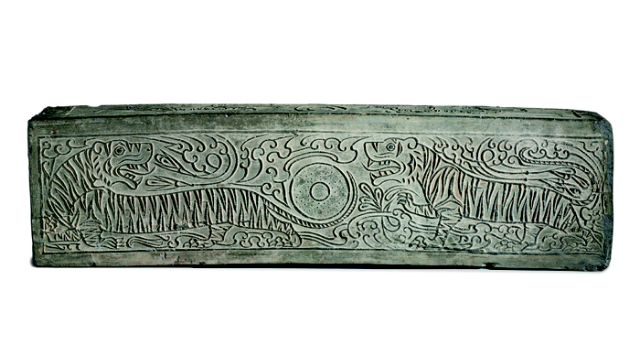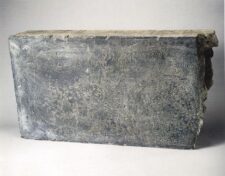
Unknown
Chinese, Xian and Xianyang regions
Hollow Brick with Tigers and Bi Disk, Architectural Element , 221–206 BCE, Qin dynasty
grey earthenware with impressed design
15 x 57 1/2 x 8 1/4 in.
SBMA, Museum purchase with John and Peggy Maximus Fund
2009.9.1
RESEARCH PAPER
The secrets of many civilizations lie in dark tombs, and the story of the Tomb Art of the Eastern Han dynasty (25-220 CE) helped preserve many of the objects that gave us the answers to their architecture, art, and belief in the after life.
Burials in ancient Chinese civilization were large and sumptuously equipped. Life was viewed as literally continuing after death, and the dead would, as they had when alive, require all the utensils of daily life and ritual. The importance of ancestral veneration and the preservation of the soul were reflected in these structures. The Burial chambers were homes of the deceased, and the buildings above ground, the temples and the halls were the places where decedents offered their respects and cared for the well being of the dead. 1
Early tombs were primarily built underground, but as time passed more complex and elaborate buildings were built above ground. In place of the vertical pits of earlier centuries, Han burials were constructed to resemble mansions or palaces. This tradition continued in later centuries with the burial chambers underground imitating the contemporary buildings above ground. The structures above ground, lay out along a central (usually north-south) axis, were preceded by a ceremonial approach from the south, known as the spirit road. The tomb was set in the context of its surroundings, using the interpretation of fengshui (wind & water). 2
The Han Dynasty was established by Liu Bang, a man of humble origins. Lasting over four hundred years, the Han Dynasty is divided into three historical periods: the Western Han (206 BCE-9 CE); a short interim dynasty Xin, (9CE-24CE), and the Eastern Han Dynasty (25CE-220CE). It was during the Eastern Han Dynasty that a combination of economic growth and Confucian philosophy emphasizing ancestor worship that led to an increase in Tomb building. The Han Emperor built colossal mausoleums that absorbed one third of the national income in taxes and tributes. 3
The impressive increase in patrons created a large market for tomb art and those who supplied this market responded with technical skills and inventiveness in subject matter. The subject matter had to be appropriate for use in the tomb and included genre scenes, different celestial beings, and a new category, examples of loyalty and filial piety.
From the early vertical pit tombs in Neolithic times, which were built out of wood, burial structures began to be increasingly constructed of hollow bricks in the early Han that were often decorated with stamped design. By the middle of the Han, the tombs included vaulted ceilings. 4
Pictorial bricks and stone bricks became the preferred media for funerary art and continued thru the Eastern Han period. Many of these examples of brick tomb chambers are still surviving.
The hollow grey bricks used in these tombs are made of loess, a kind of soft rock dust found in northern China, which can contain some clay minerals. It is composed of mainly quartz, mica, feldspar and calcite or limestone and could be used to produce low fired earthenware. 5
Large hollow bricks were used for the doorways and lintels. The popularity of pictorial brick is attested to by the hundreds and hundreds of these bricks being mass produced. The door post motifs are simple, a sentry or a pair of sentries as guards. The combination of tigers and masks are frequently used as sentry motifs. 6
The Hollow brick that the SBMA purchased may have come from the Xian region of China in the North. "It is molded on one side with two tigers confronted on a bi, two further tigers with backwards turned heads flanking another bi in a panel on top; a single tiger on one end, a rectangular opening on the other end and molded panels of repeating and alternating diamonds and an angular s-scroll on the reverse panel."
"The Hollow brick originally decorated the walls of two different chambered tombs. Judging from the decoration of tigers and bi disk (heaven) on four of its six sides, the larger hollow brick may actually serve as an architectural function that made possible viewing from both sides as well as on top." "The dynamic movement of the tiger echoes the fluid, vigorous linear quality that was typical of rarely preserved Han brush paintings."
The tiger represents a major type of imagery existing in Han tombs: the vision of immortality. Tigers represent the direction west in Han mythology, often appearing in tomb imagery with other auspicious animals: dragons (east), phoenix (south), Tortoise w/ snake (north). The tiger is called by the Chinese, the King of Beasts. He was a symbol used to scare malignant spirits from tombs. He was a protector of graves. 7
The Chinese have a "horror vacui" or dislike for bland undecorated spaces in their work of art, and craftsmen do not look upon an article as complete until by line or color he has thoroughly broken up the plainness of its surface. As in this Hollow brick, a diamond pattern alternates with angular S-scroll on the reverse panel of the Tiger motif.
CONCLUSION
As with all great civilizations, the capacity and materials could not be sustained. Even the great emperors realized that their central authority in the latter half of the Eastern Han, extravagant burials exceeding acceptable propriety and decorum, were not acceptable, eventually the Han dynasty collapsed. In the following years reacting against the Han extravagance; the scale of tomb building was greatly reduced during the next period of disunion, Three Kingdoms to Six Dynasties (220 CE-589 CE).
Prepared for the Santa Barbara Museum of Art Docent Council by Rosemarie Gebhart, June 28, 2010
1. The British Museum of Chinese Art , pg. 330
2. The Dictionary of Art , "China, II: Funerary Architecture (Han-Qing) pg 696-97
3. "Princeton University Art Museum Asian Art Collection, Qin-Han Dynasties
(221 BCE-220CE)
4. The Guide to the Tomb and Shrine Art of the Han Dynasty 206 BC-AD 220, Ch IV
5. "Earth, Fire and Water: Chinese Ceramics Technology", pg 12
6. The Guide to the Tomb and Shrine Art of the Han Dynasty 206 BC-AD 220 , Ch III
7. Outlines of Chinese Symbolism and Art Motives , pgs 398 & 117

Hollow Brick With Designs of Dragon and Bi Disc, Qin dynasty, earthenware, 8 3/8 x 15 3/8 x 6 3/4 in., Unearthed in 1974 from palace no. l at Xianyang
COMMENTS
Xianyang was the capital city of the Qin dynasty after the unification of the country. It is recorded that many palaces on a large and splendid scale were spread across the eight hundred square kilometers of Xianyang City. Unfortunately, at the end of the Qin dynasty these palaces were burned in a fire that lasted for three months. ln the 1970s, archaeologists excavated a large-scale Qin palace complex, built between the later Warring States period and the Qin dynasty. This palace was decorated with colored frescoes on white walls and constructed of hollow bricks with molded designs. This brick, found in a segment of a stairway, was molded with incised designs of a twisted dragon on among clouds, along with a bi disc decorated with a grain pattern in the center. A complete brick with an identical design was excavated in palace hall no. 2 and shows an image of a phoenix on the other side of the disc.
The dragon was an imaginary and mysterious being created by the ancient Chinese based on the characteristics of tigers, snakes, fish, and birds. lt later became a symbol for the Chinese nation and also of the ancient emperors. Archaeological finds have proved that dragon worship has a six-thousand-year history in China. Dating to the Yangshao culture, the earliest dragon design inlaid with shells, was found in Puyang City in Henan Province.
- courtesy Susan Tai, Curator of Asian Art
Hollow bricks are large architectural ceramics with a hollow core. They were made by joining flat slabs of semi-dry clay
around a removable core which may have been a sack filled with dry sand. The production included the use of wooden
frames. Hollow bricks are mostly rectangular, but were occasionally fashioned in more complex shapes to serve as ceiling,
gable, or door elements. The large and usually polished surfaces were often decorated with stamped impressions, carvings, and paintings.
Although known since the Western Zhou period, hollow bricks were widely used only from the late 3rd century bce. Hollow bricks were employed in the Qin-period Palace no. 1 in Xianyang, Shaanxi, but again mainly for lining floors and stairs. At the same time builders in Zhengzhou, Henan, began to equip tombs with hollow bricks.
- Lucas Nickel, Bricks in Ancient China and the Question of Early Cross-Asian Interaction, Arts Asiatiques, Vol. 70 (2015), pp. 51-52
SBMA CURATORIAL LABELS
This hollow brick resembles the excavated architectural remains that were once part of the walls, floors, and steps of the imperial complex at Xianyang, the capital of China’s First Dynasty’s Emperor, Qin Shihuang. Qin is pronounced chin, and is the source of the Western name China.
Decorated on four sides, it features a molded design of animated tigers amid scrolling clouds with bi disks and geometric patterns, expressive of the cosmic significance of the palace grounds. The tiger, representing the cardinal direction of the West in early Chinese mythology, may have been part of a larger decorative scheme bearing the creatures of the other four directions also found on site: dragon for the East, bird for the South, and tortoise entwined with a snake known as Xuanwu for the North. The presence of the bi disk signifies the heavenly realm.
The dynamic linear movement of the images gives evidence of the use of the brush, a drafting tool that was to become the single most important implement for Chinese scholars and artists for the next two thousand years.
- Asian Art Reopening, 2021
Originally part of an underground tomb wall in north China, this hollow brick, features images of animated tigers amid scrolling clouds on one side and geometric patterns on reverse. In Han mythology, tigers, representing the direction of the west, often appear in tomb imagery with other auspicious animals guarding the deceased soul: dragons (east), phoenix (south), and a tortoise with a snake (north). The concentric circles at the center, the bi disc, symbolizes the heavenly realm where the immortals dwell. The dynamic movement of the linear images gives evidence to the use of brush that were to become the single most important tool for Chinese scholars and artists for the next two thousand years.
- Ridley-Tree Gallery, 2016
